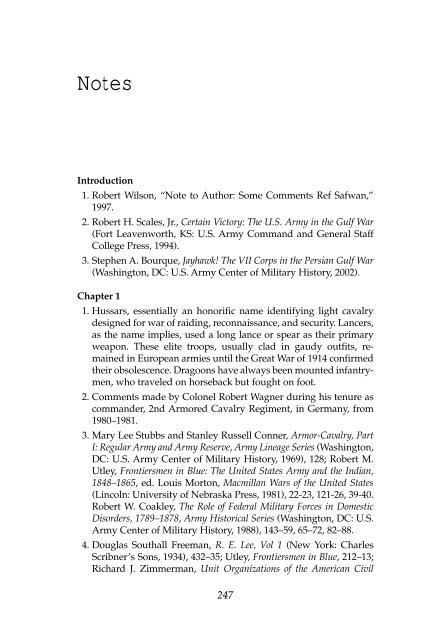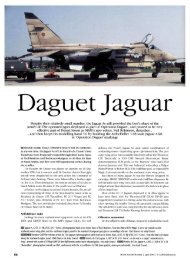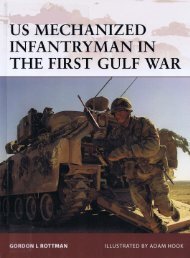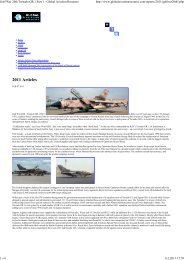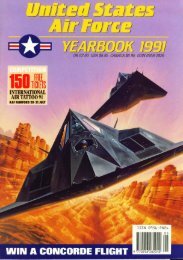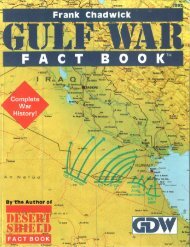- Page 2:
THE ROAD TO SAFWAN
- Page 5 and 6:
©2007 Stephen A. Bourque and John
- Page 8:
Contents List of Illustrations . .
- Page 12:
List of Photographs List of Photogr
- Page 15 and 16:
2 The Road to Safwan ahawk missiles
- Page 17 and 18:
4 The Road to Safwan This manuscrip
- Page 19 and 20:
6 The Road to Safwan book would nev
- Page 21 and 22:
8 The Road to Safwan commanders fou
- Page 23 and 24:
10 The Road to Safwan Harz Mountain
- Page 25 and 26:
12 The Road to Safwan time, he look
- Page 27 and 28:
14 The Road to Safwan problem and a
- Page 29 and 30:
16 The Road to Safwan ment was now
- Page 31 and 32:
18 The Road to Safwan weapons syste
- Page 33 and 34:
20 The Road to Safwan surveillance
- Page 35 and 36:
22 The Road to Safwan headquarters
- Page 37 and 38:
24 The Road to Safwan equipment to
- Page 39 and 40:
26 The Road to Safwan Teflon-based
- Page 41 and 42:
28 The Road to Safwan ready to figh
- Page 43 and 44:
30 The Road to Safwan Brigade began
- Page 45 and 46:
32 The Road to Safwan unmarried (or
- Page 47 and 48:
34 The Road to Safwan deploying to
- Page 49 and 50:
36 The Road to Safwan normal. A few
- Page 51 and 52:
38 The Road to Safwan navigator on
- Page 53 and 54:
40 The Road to Safwan the airlines
- Page 55 and 56:
42 The Road to Safwan west Asia and
- Page 57 and 58:
44 The Road to Safwan Forbes Field
- Page 59 and 60:
46 The Road to Safwan cranes to lif
- Page 61 and 62:
48 The Road to Safwan to find enoug
- Page 63 and 64:
50 The Road to Safwan diers broke o
- Page 65 and 66:
52 The Road to Safwan RIYADH RIYADH
- Page 67 and 68:
54 The Road to Safwan tion, COL Mow
- Page 69 and 70:
56 The Road to Safwan closely contr
- Page 71 and 72:
58 The Road to Safwan This was a dr
- Page 73 and 74:
60 The Road to Safwan thought was a
- Page 75 and 76:
62 The Road to Safwan Tedesco was t
- Page 77 and 78:
64 The Road to Safwan assembly area
- Page 79 and 80:
66 The Road to Safwan toon.” It w
- Page 81 and 82:
68 The Road to Safwan could delay t
- Page 83 and 84:
70 The Road to Safwan left for DSA
- Page 85 and 86:
72 The Road to Safwan Marable had n
- Page 87 and 88:
74 The Road to Safwan squadron’s
- Page 89 and 90:
76 The Road to Safwan In the course
- Page 91 and 92:
78 The Road to Safwan ported an uni
- Page 93 and 94:
7 Combat Command Carter Even before
- Page 95 and 96:
82 The Road to Safwan the squadron
- Page 97 and 98:
84 The Road to Safwan leaders belie
- Page 99 and 100:
86 The Road to Safwan to the rear f
- Page 101 and 102:
88 The Road to Safwan indicating th
- Page 103 and 104:
90 The Road to Safwan corps and arm
- Page 105 and 106:
92 The Road to Safwan to fire, whic
- Page 107 and 108:
94 The Road to Safwan grenades into
- Page 109 and 110:
96 The Road to Safwan would be much
- Page 111 and 112:
98 The Road to Safwan promised his
- Page 113 and 114:
100 The Road to Safwan At 0055 hour
- Page 115 and 116:
102 The Road to Safwan members perf
- Page 117 and 118:
104 The Road to Safwan alerted him
- Page 119 and 120:
106 The Road to Safwan Command. The
- Page 121 and 122:
108 The Road to Safwan 2nd Cavalry
- Page 123 and 124:
110 The Road to Safwan ered a crack
- Page 125 and 126:
112 The Road to Safwan handy guide
- Page 127 and 128:
114 The Road to Safwan SAUDI ARABIA
- Page 129 and 130:
116 The Road to Safwan A Figure 2 1
- Page 131 and 132:
118 The Road to Safwan helped turn
- Page 133 and 134:
120 The Road to Safwan dure, worked
- Page 135 and 136:
122 The Road to Safwan Christopher
- Page 137 and 138:
124 The Road to Safwan toothed plow
- Page 139 and 140:
126 The Road to Safwan observer, mo
- Page 141 and 142:
128 The Road to Safwan completed it
- Page 143 and 144:
130 The Road to Safwan render. As t
- Page 145 and 146:
132 The Road to Safwan a mortar or
- Page 147 and 148:
11 Objective Norfolk In the early m
- Page 149 and 150:
136 The Road to Safwan the enemy un
- Page 151 and 152:
138 The Road to Safwan oped a serie
- Page 153 and 154:
140 The Road to Safwan cloud ceilin
- Page 155 and 156:
142 The Road to Safwan squadrons wi
- Page 157 and 158:
144 The Road to Safwan lane for eac
- Page 159 and 160:
146 The Road to Safwan cated there.
- Page 161 and 162:
148 The Road to Safwan they were su
- Page 163 and 164:
150 The Road to Safwan platoon occu
- Page 165 and 166:
152 The Road to Safwan 2-34 3-7 II
- Page 167 and 168:
154 The Road to Safwan B ATK I 3-7
- Page 169 and 170:
156 The Road to Safwan arm the Iraq
- Page 171 and 172:
158 The Road to Safwan radio that o
- Page 173 and 174:
160 The Road to Safwan Iraq’s rem
- Page 175 and 176:
162 The Road to Safwan OBJECTIVE ZI
- Page 177 and 178:
164 The Road to Safwan lier in the
- Page 179 and 180:
166 The Road to Safwan erally tryin
- Page 181 and 182:
168 The Road to Safwan commander, a
- Page 183 and 184:
170 The Road to Safwan tion on the
- Page 185 and 186:
172 The Road to Safwan mingle with
- Page 187 and 188:
174 The Road to Safwan around, Burd
- Page 189 and 190:
176 The Road to Safwan sion and wor
- Page 191 and 192:
178 The Road to Safwan continuously
- Page 193 and 194:
180 The Road to Safwan up and surre
- Page 195 and 196:
182 The Road to Safwan cross on his
- Page 197 and 198:
184 The Road to Safwan When out of
- Page 199 and 200:
B Troop, at the Jay Hawk Firing Ran
- Page 201 and 202:
Late afternoon, 24 February 1991, 2
- Page 203 and 204:
According to Steve Gruenig, Mr. Phi
- Page 205 and 206:
Basra Highway, 28 February 1991, (l
- Page 207 and 208:
Squadron S3 Staff Section, Khobar T
- Page 209 and 210:
186 The Road to Safwan bodies with
- Page 211 and 212:
188 The Road to Safwan to senior co
- Page 213 and 214:
190 The Road to Safwan everyone a g
- Page 215 and 216:
192 The Road to Safwan officer race
- Page 217 and 218:
194 The Road to Safwan tion on the
- Page 219 and 220: 196 The Road to Safwan 1 MOVE
- Page 221 and 222: 198 The Road to Safwan airfield jus
- Page 223 and 224: 200 The Road to Safwan brigade offi
- Page 225 and 226: 202 The Road to Safwan dam Hussein
- Page 227 and 228: 204 The Road to Safwan The context
- Page 229 and 230: 206 The Road to Safwan British troo
- Page 231 and 232: 208 The Road to Safwan 180 degrees
- Page 233 and 234: 210 The Road to Safwan engineer tea
- Page 235 and 236: 212 The Road to Safwan soldiers wer
- Page 237 and 238: 214 The Road to Safwan vision at Sa
- Page 239 and 240: 216 The Road to Safwan of home bega
- Page 241 and 242: 218 The Road to Safwan some soldier
- Page 243 and 244: 220 The Road to Safwan server could
- Page 245 and 246: 222 The Road to Safwan camels as if
- Page 247 and 248: 224 The Road to Safwan At CP India
- Page 249 and 250: 226 The Road to Safwan civilians ov
- Page 251 and 252: 228 The Road to Safwan minus those
- Page 253 and 254: 230 The Road to Safwan continue the
- Page 255 and 256: 232 The Road to Safwan A Troop. CPT
- Page 257 and 258: 234 The Road to Safwan With over si
- Page 259 and 260: 236 The Road to Safwan crews sittin
- Page 261 and 262: 238 The Road to Safwan camouflage u
- Page 263 and 264: 240 The Road to Safwan winter and s
- Page 265 and 266: 242 The Road to Safwan different st
- Page 267 and 268: 244 The Road to Safwan forces) Trac
- Page 269: 246 The Road to Safwan cal Army Res
- Page 273 and 274: 250 The Road to Safwan Desert Storm
- Page 275 and 276: 252 The Road to Safwan Squadron, 4t
- Page 277 and 278: 254 The Road to Safwan 6. 1st Squad
- Page 279 and 280: 256 The Road to Safwan emerged duri
- Page 281 and 282: 258 The Road to Safwan 17. Wehage i
- Page 283 and 284: 260 The Road to Safwan potential we
- Page 285 and 286: 262 The Road to Safwan Chapter 10 1
- Page 287 and 288: 264 The Road to Safwan Squadron, 4t
- Page 289 and 290: 266 The Road to Safwan referred to
- Page 291 and 292: 268 The Road to Safwan 51. Bills in
- Page 293 and 294: 270 The Road to Safwan 13. 1-4 Cava
- Page 295 and 296: 272 The Road to Safwan 46. 1st Infa
- Page 297 and 298: 274 The Road to Safwan 21. Rhame in
- Page 299 and 300: 276 The Road to Safwan 7 March 1991
- Page 301 and 302: 278 The Road to Safwan 15. Osburn i
- Page 303 and 304: Glossary 1IDF 1st Infantry Division
- Page 305 and 306: 282 The Road to Safwan soldiers. Co
- Page 307 and 308: 284 The Road to Safwan HHT Headquar
- Page 309 and 310: 286 The Road to Safwan ROTC Reserve
- Page 311 and 312: Bibliography For such a short confl
- Page 313 and 314: 290 The Road to Safwan Lieutenant G
- Page 315 and 316: 292 The Road to Safwan Clancy, Tom,
- Page 317 and 318: 294 The Road to Safwan Nilsen, Davi
- Page 319 and 320: 296 The Road to Safwan Van Creveld,
- Page 321 and 322:
298 The Road to Safwan 219, 221, 22
- Page 323 and 324:
300 The Road to Safwan British Army
- Page 325 and 326:
302 The Road to Safwan Division Sup
- Page 327 and 328:
304 The Road to Safwan Humanitarian
- Page 329 and 330:
306 The Road to Safwan Karns, 2LT,
- Page 331 and 332:
308 The Road to Safwan Phase Lines
- Page 333 and 334:
310 The Road to Safwan Schullo, CW3
- Page 335:
312 The Road to Safwan Air Troop Re


